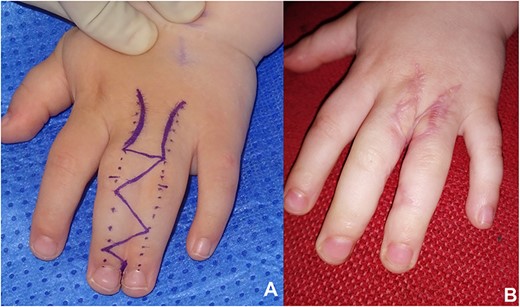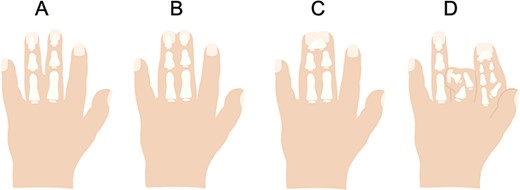-
PDF
- Split View
-
Views
-
Cite
Cite
Luke Geoghegan, Billie Georgina Knowles, Dariush Nikkhah, Syndactyly, Journal of Surgical Case Reports, Volume 2020, Issue 12, December 2020, rjaa517, https://doi.org/10.1093/jscr/rjaa517
Close - Share Icon Share
Abstract
Here we present an interesting case of simple syndactyly and provide a narrative review of its incidence, associations and management.
INTRODUCTION
Syndactyly is the most common congenital abnormality of the hand and is estimated to affect 1 in 2000 new-borns [1]. It is more common in males and can occur both unilaterally and bilaterally with equal incidence [2]. Syndactyly can be inherited or sporadic, when inherited it can be non-syndromic or as part of a syndrome such as Apert’s syndrome [3].
CASE REPORT
An 18-month-old child presented to the paediatric hand clinic with a fused ring and middle finger on the left hand. The child was born at term with an unremarkable past medical history and no family history of congenital abnormalities. On examination there was webbing of the ring and middle finger extending past the distal interphalangeal joint without synonychia (Fig. 1a). There was no visible shortening of the affected digits and range of motion at the metacarpophalangeal, proximal and distal interphalangeal joints was preserved. On general examination there were no syndromic features and examination of the feet and contralateral hand was unremarkable. The child was diagnosed with simple incomplete syndactyly and underwent surgical release using a modified Flatt technique, where a dorsal hourglass flap, interdigitating zigzag flaps and a full thickness skin graft were used to reconstruct the webspace [4]. An excellent aesthetic outcome was obtained (Fig. 1b) and the child retains full use of the left hand without pain.

(A) Simple incomplete syndactyly demonstrating fusion of the middle and ring finger (B) Outcome following syndactyly release at 6 months post-operatively.
DISCUSSION
Here we present an interesting case of simple incomplete syndactyly. Syndactyly can be classified as complete or incomplete (indicated by the degree of fusion), simple (where only soft tissue is involved), complex (synostosis between adjacent phalanges) and complicated (accessory phalanges or abnormal bones involved in fusion) [5] (Fig. 2). Syndactyly release is performed under general anaesthesia using a paediatric tourniquet. A multitude of techniques have been proposed for commissure reconstruction. Traditionally, skin grafts have been used to cover bare areas following web separation however these techniques are limited by web creep and donor site morbidity. Local reconstructive techniques using dorsal metacarpal advancement flaps have been refined over recent years and may have lower rates of early postoperative complications, web creep, contracture, hypertrophic scarring and revision surgery [2]. Interdigitating zigzag dorsal and palmar flaps may be used to minimize the tendency for formation of longitudinal scars and flexion contracture whilst maximizing soft tissue coverage potential [6]. Here a modified Flatt technique was used which involves the use of a dorsal hourglass flap, interdigitating zigzag flaps and full thickness skin grafts to provide adequate soft tissue coverage [4].

Diagrammatic representation of syndactyly subtypes (A) simple, incomplete (B) simple, complete (D) complex (D) complicated.
CONFLICT OF INTEREST STATEMENT
None declared.
FUNDING
None.



